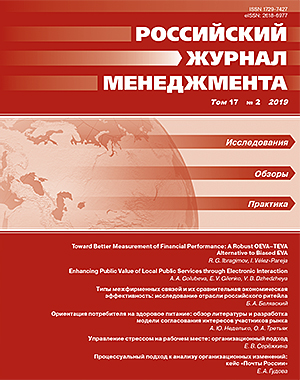Типы межфирменных связей и их сравнительная экономическая эффективность: исследование отрасли российского ритейла
DOI:
https://doi.org/10.21638/spbu18.2019.203Аннотация
В статье на основе концепций маркетинга взаимоотношений, стратегического менеджмента и новой экономической социологии обсуждаются два принципа классификации межфирменных связей — по горизонтальному и вертикальному типам отношений. Предложена оригинальная авторская типология моделей межфирменных связей, состоящая из четырех идеальных типов. Оцениваются количественная распространенность каждого из типов отношений и их сравнительная экономическая эффективность по динамике продаж, изменению товарного ассортимента и положению относительно конкурентов. Для эмпирического анализа используются данные стандартизированного опроса 684 менеджеров компаний (ритейлеров и поставщиков), работающих в России на рынках продовольственных и непродовольственных товаров, проведенного НИУ ВШЭ в 2016 г. В результате анализа выявлены высокая распространенность выстраивания интенсивных межфирменных отношений в цепи поставок и низкая — в сетевых связях с конкурентами. Сочетание горизонтальных связей с конкурентами и выстраивание вертикальных отношений в соответствии с концепцией маркетинга взаимоотношений, как показало исследование, связано с наиболее высокими показателями экономической эффективности.
Ключевые слова:
межфирменные связи, экономическая эффективность, маркетинг взаимоотношений, экономическая социология, ритейл, Россия
Скачивания
Библиографические ссылки
ЛИТЕРАТУРА НА РУССКОМ ЯЗЫКЕ
REFERENCES IN LATIN ALPHABET
Translation of references in Russian into English
Загрузки
Опубликован
Как цитировать
Выпуск
Раздел
Лицензия
Статьи журнала «Российский журнал менеджмента» находятся в открытом доступе и распространяются в соответствии с условиями Лицензионного Договора с Санкт-Петербургским государственным университетом, который бесплатно предоставляет авторам неограниченное распространение и самостоятельное архивирование.





